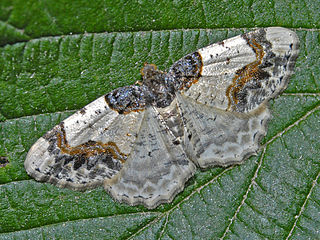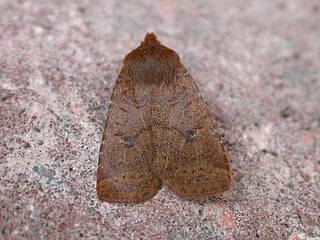Related Research Articles

The common footman is a moth of the family Erebidae. The species was first described by Johann Leopold Theodor Friedrich Zincken in 1817. It is distributed throughout Europe and east through the Palearctic to Lake Baikal.
Pithanurga is monotypic moth genus in the family Gelechiidae. Its only species, Pithanurga chariphila, is found in South Africa. Both the genus and species were first described by Edward Meyrick in 1921.

Ligdia adustata, the scorched carpet, is a moth of the family Geometridae.

Conistra vaccinii, the chestnut, is a moth of the family Noctuidae. The species was first described by Carl Linnaeus in 1761. It is distributed throughout Europe, North Africa and east through the Palearctic to Siberia.
Enscepastra longirostris is a species of moth of the family Coleophoridae. It is known from South Africa.
Enscepastra plagiopa is a species of moth of the family Coleophoridae. It is known from South Africa.
Anachastis is a genus of moths of the family Xyloryctidae from the Seychelles. It contains only one species, Anachastis digitata.

Callopistria latreillei, Latreille's Latin, is a moth of the family Noctuidae. The species can be found in the Palearctic realm, most parts of Europe, Asia, and in Africa from Egypt to South Africa. The habitat consists of rocky limestone slopes with deciduous woodland.
Anarsia carbonaria is a moth of the family Gelechiidae. It was described by Edward Meyrick in 1913. It is found in South Africa and Zimbabwe.
Arbelodes deprinsi is a moth in the family Cossidae. It is found in South Africa, where it has been recorded from the forest-grassland mosaic of the Dragon Peaks Mountain Resort.
Syllepte achromalis is a moth in the family Crambidae. It was described by George Hampson in 1912. It is found in Cameroon, Nigeria and Sierra Leone.
Syllepte disciselenalis is a moth in the family Crambidae. It was described by George Hampson in 1918. It is found in Malawi.
Dichomeris coenulenta is a moth in the family Gelechiidae. It was described by Edward Meyrick in 1927. It is found in Zimbabwe.
Scrobipalpa subroseata is a moth in the family Gelechiidae. It was described by Edward Meyrick in 1932. It is found in Uganda.
Lasiarchis pycnodes is a moth in the family Gelechiidae. It was described by Edward Meyrick in 1909. It is found in Gauteng, South Africa.
Mysaromima liquescens is a moth of the family Depressariidae. It is found in Colombia and Brazil.
Heteronygmia dissimilis is a species of moth in the subfamily Lymantriinae first described by Per Olof Christopher Aurivillius in 1910. It is native to Africa. The adult moth is on wing from February to November, but is most common between June and September. The larvae feed on the foliage of the East African mahogany and when they are plentiful, they can defoliate the tree.
Moca pelinactis is a moth in the family Immidae. It was described by Edward Meyrick in 1925. It is found in Cameroon.
Tineola atricoma is a species of fungus moth. It is known from Antananarivo, Madagascar.
Amphixystis cymataula is a moth of the family Tineidae. It was described by Edward Meyrick in 1909 and is found in Zimbabwe.
References
| Wikimedia Commons has media related to Enscepastra lathraea . |
| Wikispecies has information related to Enscepastra lathraea . |
- ↑ De Prins, J. & De Prins, W. (2017). "Enscepastra lathraea (Meyrick, 1920)". Afromoths. Retrieved December 16, 2017.